The Mysterious Fayum Portraits Michael Lahanas Πορτραίτα του Φαγιούμ |
Το βλέμμα τους είναι οικείο διότι το συναντάς σε βυζαντινές εικόνες. Είναι ένα βλέμμα προσωπικού αποχαιρετισμού που σε βλέπει κατάματα και συγχρόνως σε διαπερνά, κυττώντας μακρυά, πέρα απο σένα. (Source ) Their look is familiar to you because you know these images from Byzantine icons. It is a look of a personal farewell, they look at your eyes directly but simultaneously also through you far away.
The Fayum Portraits: Greek and Roman painting style, encaustic (εγκαυστική) (from enkaio “to burn-in” ) on wood, part of the Egyptian culture (funeral portraits). They show the faces of the inhabitants of ancient Egypt at a period influenced by Greeks and Romans. The Fayum portraits are the best preserved paintings of Antiquity. Some of these produced by Greeks who worked in Egypt, part of the Greek population that settled in cities like Alexandria, when Egypt was ruled by Greek kings after the peaceful conquest of Egypt by Alexander the Great. The portraits, many from Fayum, are from a period when Romans followed the Greeks as rulers and their influence is shown (for example Roman fashion). Examples were found in various Necropolises: in Memphis (Saqqara), Philadelphia (Er-Rubayat and ‘Kerke’), Arsinoe (Hawara), Antinoopolis, Panopolis (Akhmim), Marina el-Alamein, Thebes and el-Hiba (Ankyronpolis) and other places.
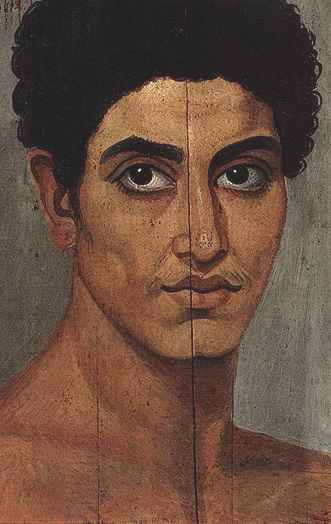
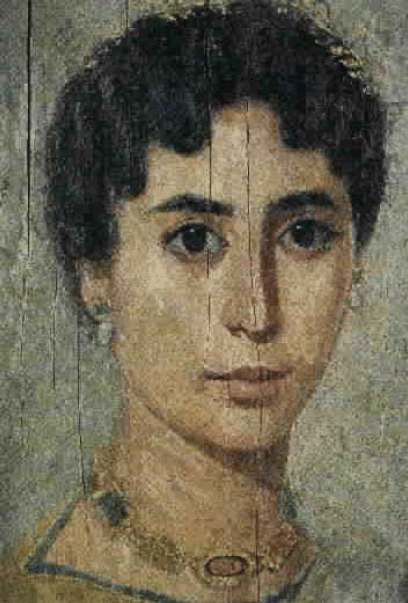
For the left image: (Diogenes the flute player, a Jew? ) from Portrait-Painting in Ancient Egypt." by Amelia Ann Blanford Edwards: “Finer by far, as a work of art, is the portrait of a young man named Diogenes He was apparently a professional musician. A small wooden label found with the mummy-case calls him "Diogenes of the Flute of Arsinoe;" while a second inscription, written in ink upon one of the mummy-wrappings, describes him as "Diogenes who abode at the Harp when he was alive." From these it is evident that he was a flautist, born in the city of Arsinoe, and that when he came to live at Hawara, he lodged at the sign of the Harp. The panel, like too many others, is badly cracked; but the head is so characteristic, and the expression so fine, that not even this blemish mars its effect. There is a set look in the face, as of some solemn purpose to be fulfilled; and the eyes arrest us, like the eyes of a living man. The hair is very thick and curly, and the features are distinctly Jewish in type. That he should be a Jew would be quite in accordance with his profession for the gift of music has ever been an inheritance of the children of Israel. “
The right image: Portrait of a woman, probably from er-Rubayat, c. 160-170 AD, British Museum, London

The Artemidorus mummy with scenes from Egyptian religion (Anubis or Anpu at the bed of the dead with his sisters Isis and Nephthys, Horus and Thoth around an emblem of Osiris. The soul of the dead in the form of a bird). Elements of Egyptian Religion in the Roman period with Greek text (Artemidorus farewell)
![]()
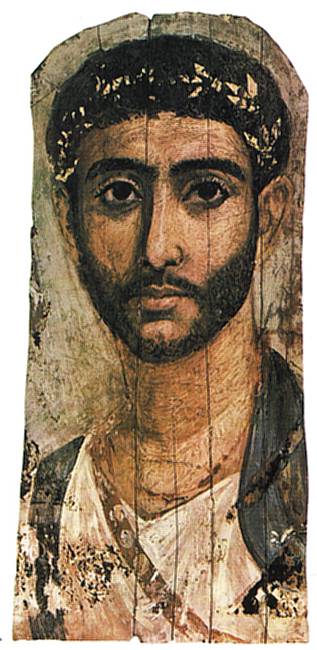
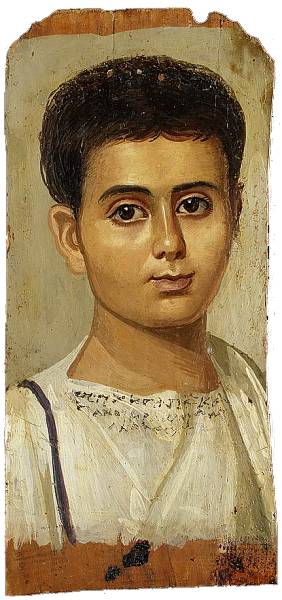
From Euphrosyne Doxiadis (1995): The Mysterious Fayum Portraits: Faces from Ancient Egypt. Paintings from the 1st century BC to 3rd century AD. The climate in Egypt and the conditions there allowed these paintings to survive. Similar Hellenistic – Egyptian paintings were produced in many places of the Roman Empire but only in Fayum many examples were found. The image of a woman could be similar to the portraits produced by Iaia of Cyzicus, a woman Greek painter. According to Pliny the Elder she worked in Rome producing paintings of women and a self-portait. These portraits on wooden panels included in mummies probably represent the deceased. The instruments used:
- cauter or cauterium (καυτήρ, καυτήριον), an instrument used to fix the colors
- penicillum or penicill ( ράβδιον), a brush
- cestrum (κέστρον), a (probably hot) graver
How and if these instruments as Pliny mentions were used is actually not knownas the opinions of the experts differ. As the portraits show young men and women either they show the persons when they were young or it shows also that the life expectancy at that time was rather small. The encausting technique was a Greek method used in Egypt to produce these brilliant paintings. The method originated in Classical Greece in the fifth and fourth centuries BC.
Among these portraits there is a young boy with a Greek name, Eutyhes . His name probably is derived from eu and tyhe which means good and luck or lucky and in modern Greek also happy. But he was probably not so lucky and died very young probably around 50-100 AD. Due to the influence of the Greeks in Egypt for around 300 years and later the Romans many persons shown have Greek names and wear Roman clothes but their religion is Egyptian.
A.J.N.W. Prag, Proportion and personality in the Fayum Portraits (PDF File)
A database with Fayum portraits (use the French part ..)
More Fayum Faces from the Metropolitan Museum , More examples from Wikipedia
Chapter 3: Portrait-Painting in Ancient Egypt." by Amelia Ann Blanford Edwards (1831-1892)
References
Euphrosyne Doxiadis, The Mysterious Fayum Portraits Faces from Ancient Egypt , Thames & Hudson 1995, ISBN 0-500-23713-1 An excellent book with interesting information and many beautiful examples
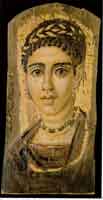
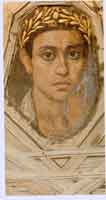
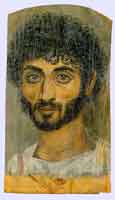
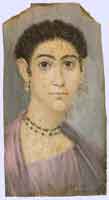
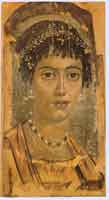
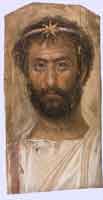
No comments:
Post a Comment